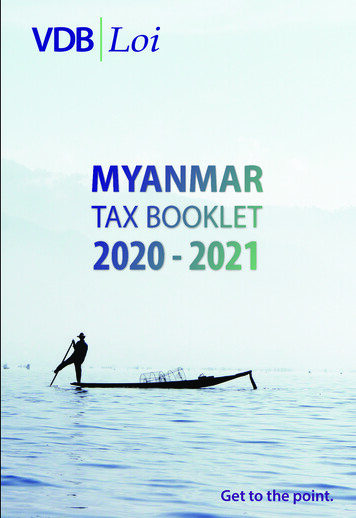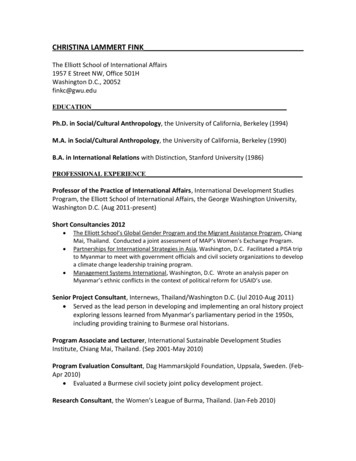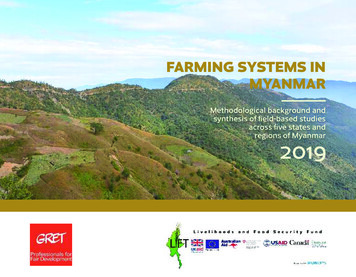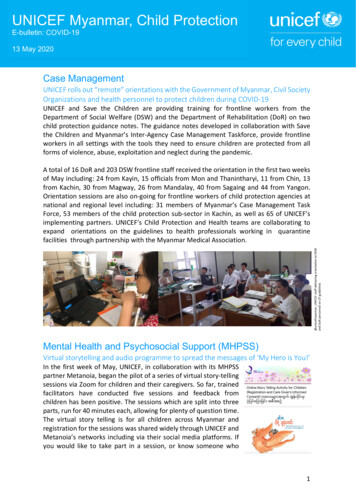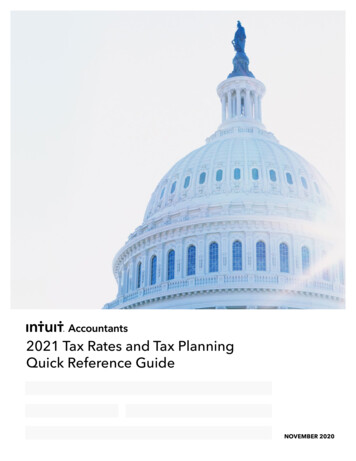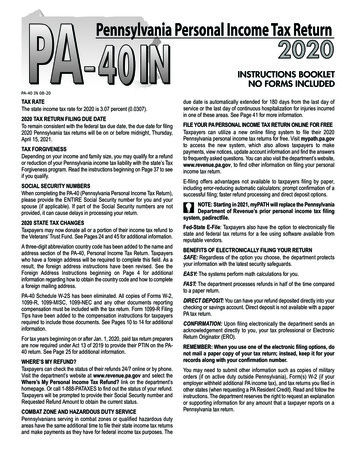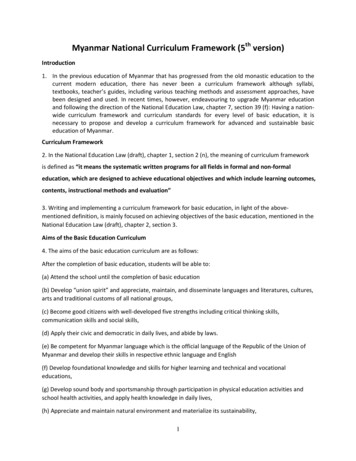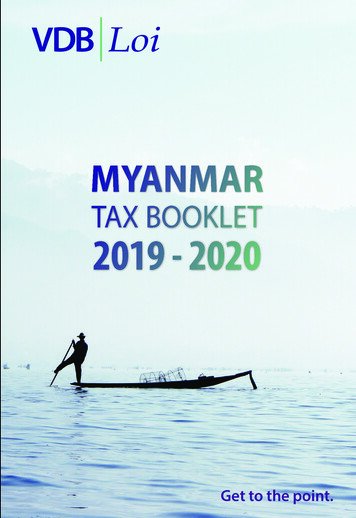
Transcription
MYANMARTAX BOOKLET2019 - 2020Get to the point.
VDB LOI CO., LTDAll rights reserved. No part of this publication may be reproduced, stored in a retrieval system or transmitted,in any form or by any means – electronic, mechanical, photocopying, recording or otherwise – without theprior written permission of the publisher or copyright holder. This publication, and any form of copy of thispublication, may not be sold, re-sold, hired out or otherwise disposed of by way of trade, by any person orentity, without the prior written permission of the publisher or copyright holder.Published by VDB Loi Co., Ltd November 2020Version 1.0Disclaimer: All information is considered correct as of the publication date; however it is not intendedto be relied upon. For the most up-to-date information, please contact one of our advisers or visit ourwebsite at www.vdb-loi.com
ContentsAbbreviations. 1Corporate Income Tax. 2Rates of tax . 2Deductibility . 2Depreciation . 2Loss carry forward . 22% Advanced Income Tax on importation and exportation. 3Withholding Tax. 4Overview. 4Exemption of WHT. 5Minimum threshold. 5Double Taxation Agreement . 5Capital Gains Tax . 6Overview. 6Income threshold for paying CGT . 6Rates of tax . 6Calculation of CGT. 6Personal Income Tax. 7Overview . 7Residency. 7Taxable salary. 7Tax reliefs and allowances for Myanmar residents. 7Rates of tax. 8Social Security Contributions. 8Undisclosed source of income. 9Rental income. 10Double Taxation Agreement . 11Commercial Tax. 12Overview. 12Non-taxable goods and services. 12Revenue threshold for charging and paying CT . 12Registration . 12Rates of tax. 12Basis of taxation. 13Offsetting input and output CT . 13
Specific Goods Tax. 14Overview. 14SGT exemptions. 14Revenue threshold for charging and paying SGT. 14Registration. 14Rates of tax. 14Basis of taxation. 15Offsetting input and output SGT. 15Jewelry Tax. 16Overview . 16Tax Compliance Requirements . 17Compliance timelines and penalties . 17Other Taxes. 19Stamp Duty. 19Property Tax. 19Customs Duty. 19Investment Incentives. 20Myanmar Investment Commission incentives. 20Special Economic Zone incentives. 21Investment and Free Trade Agreements . 22Annex 1: Tax Depreciation Schedule. 23Annex 2: Commercial Tax-exempted Goods. 29Annex 3: Commercial Tax-exempted Services. 34Annex 4: Specific Goods Tax rates for local production and importation. 37Annex 5: Specific Goods Tax rates for export. 41Annex 6: Selected Stamp Duty Schedules. 42Agreements and Counterparts. 42Bond. 44Conveyance, lease, mortgage and re-conveyance. 45Promissory Note. 49Transfer. 50
MOPFIPITPTSDSEZSGTUTLWHTDefinitionASEAN Comprehensive Investment AgreementBilateral Investment TreatiesCapital Gains TaxCost, insurance and freightCorporate Income TaxCommercial TaxDouble Taxation AgreementFree Trade AgreementInternal Revenue DepartmentIncome Tax LawMyanmar Investment CommissionMinistry of Planning, Finance and IndustryPersonal Income TaxProperty TaxStamp DutySpecial Economic ZoneSpecific Goods TaxUnion Tax LawWithholding TaxPage 1
Corporate Income TaxRates of taxThe current corporate income tax (“CIT”) rate is 25% for Myanmar companies,branches registered under the Myanmar Companies Law (“MCL”) 2017, andcompanies operating under an investment license from Myanmar InvestmentCommission (“MIC”) (i.e. foreign-owned resident companies with an investmentlicense from the MIC granted under the Foreign Investment Law and MyanmarInvestment Law 2016). However, please note that CIT rate for companies listedon the Yangon Stock Exchange is 20% effective from 2017-2018 income year.Resident entities, which are defined as companies established under the MCLare obliged to declare and pay CIT on their worldwide income. Non-residents,including branches or overseas corporations registered under the MCL, are onlyobliged to pay CIT on their Myanmar-sourced income.DeductibilityGenerally, expenditures incurred for the purpose of earning business incomeare deductible, subject to certain limitations. Capital expenditures, personalexpenditures, expenditures not commensurate with the volume of business,inappropriate expenditures, expenditures incurred for purposes other thanearning such income, and payments made to a member of an association ofpersons other than a company or a cooperative society, are not deductible.DepreciationA depreciation allowance is deductible for CIT purposes. Capital assets must becapitalized and depreciated on a straight-line basis in accordance with the ratesset out in Notification 19/2016, the Second Regulations Amending the IncomeTax Regulations. If a taxpayer wishes to use a different tax depreciation rate ora method, a request can be submitted to the IRD starting from FY2019-2020. Ifthe IRD approves, different tax depreciation rate or method can be applied. Afull-year depreciation allowance can be claimed for the year in which a capitalasset is acquired, regardless of whether the asset is used for all or part of thatyear. Please refer to Annex 1 (Page 23) for detailed tax depreciation rates.Loss carry forwardUnder the Income Tax Law 1974 (“ITL”), a tax loss incurred by a company canbe carried forward for up to three consecutive years and can be offset againsttaxable profits in the future, with the exception of capital losses.Page 2
2% Advanced Income Tax on importation and exportationCompanies importing or exporting goods must pay a 2% Advanced Income Tax(“AIT”) on the assessed value of the goods for import and export. There are afew exceptions, including the import of materials and equipment during theconstruction period of projects, and raw materials imported during the firstthree years of production under an investment license from MIC. The tax that iscollected as an AIT can be offset against the annual CIT liability.Page 3
Withholding TaxOverviewThe MOPF released Notification 47/2018 (“Notification 47/2018”) on 18 June2018 which revokes the Withholding Tax (“WHT”) Notification 51/2017. TheNotification 47/2018 is effective from 1 July 2018 (FY2018-2019). Please refer tobelow table in relation to payments subject to WHT under Notification 47/2018.Type of IncomeInterestsRoyaltiesGoods (Locally purchased goods)–payments made by governmentorganizations, ministries and stateowned enterprisesGoods (Locally purchased goods) –payments made by others apart fromgovernment organizations, ministriesand state-owned enterprisesServices (Locally rendered services)–payments made by governmentorganizations, ministries and stateowned enterprisesServices (Locally rendered services) –payments made by others apart fromgovernment organizations, ministriesand state-owned 0%2.5%The Notification 47/2018 imposes legal obligation on the payer to deduct WHTfrom payments that are subject to WHT, regardless of whether the incomerecipient has agreed to the deduction or not. Please note that the IRD mayrecover the WHT from the payer if the payer is failed to deduct applicable WHT.The payer can be a resident taxpayer or a non-resident taxpayer. The obligationfor deducting WHT rests with the payer.Page 4
Exemption of WHTExemption from WHT deduction is given to payments between governmentorganizations, and payments made to respective government organizationsand stated-owned enterprises and interest payments to non-resident lenderswho open branches locally or file corporate income tax return for incomederived from the branch. Previously, Myanmar branches of foreign banks wereconsidered non-residents and are thus captured in Myanmar’s 15% WHT rateon interest paid to non-residents. From 1 April 2017, the WHT on interestpayment to the Myanmar branches of foreign banks will no longer apply.Minimum thresholdUnder Notification 47/2018, there is a minimum threshold of MMK 1 millionfor total payments within a year period for payments made by governmentorganizations, ministries and state-owned enterprises. However, there is nominimum threshold for payments made to non-residents.Double Taxation AgreementIf the non-resident taxpayer is a resident taxpayer of a country with whichMyanmar has a tax treaty, a relief may be available under the DTA. The IRDwill require the non-resident to provide the Certificate of Residence issued bythe tax authority of their country of residence. However, in order to enjoy thereliefs under the DTA, an application must be made to the IRD for approval.Page 5
Capital Gains TaxOverviewCapital assets include land, buildings and their rooms, vehicles, and workrelated capital assets. The expression also includes shares, bonds, securitiesand similar instruments. Capital gains tax (“CGT”) is applicable to both residentand non-resident taxpayers deriving a profit from the sale, exchange, or transferof capital assets in Myanmar. CGT is payable by the person deriving the gains.A CGT return must be lodged by any person who sells, exchanges or transferscapital assets, even if there is no gain or loss.Income threshold for paying CGTIf the total sale-value of the capital asset; which was sold, exchanged ortransferred, does not exceed MMK 10 million, CGT will not be applicable.Rates of taxThe CGT rate for all taxpayers (with the exception of those deriving a gain froman upstream oil and gas asset or a company holding an upstream oil and gasasset) is 10%, and is imposed in either MMK or a foreign currency.CGT for upstream oil and gas sector must be paid in the same currency in whichthe gain was received. The following rates apply:Capital gain123Up to MMK100 billionFrom over MMK100 billion to MMK150 billionOver MMK150 billionTax rate40%45%50%Calculation of CGTCGT is calculated on the full value of the sale, exchange or transfer afterdeducting depreciation, the original asset cost, any capital expenditures toincrease the life of the asset, and any expenditures incurred in the procurement,sale, exchange or transfer of the asset. Deprecation is not allowed for the yearof disposal of the capital asset.Page 6
Personal Income TaxOverviewEmployers, whether residents or non-residents of Myanmar for tax purposes,are liable to deduct personal income tax (“PIT”) from payments of salaries,wages and other remuneration made to all employees. Employees that areresidents of Myanmar (both Myanmar nationals and foreigners) are taxed ontheir worldwide income at progressive rates after deducting the prescribedallowances and reliefs; whereas non-residents are taxed only on their Myanmarsourced income, at the same progressive rates.ResidencyA foreign individual is considered as a resident foreigner for tax purposes ifthey are residing in Myanmar for 183 days and more during an income year (1October to following 30 September). Accordingly, foreigners who are residing inMyanmar for less than 183 days are considered non-resident foreigners.Taxable salarySalary income as defined by the ITL includes “salary, wages, annuities, bonuses,awards, and fees or commissions received in lieu of or in addition to the salaryor wages”. Taxable benefits are not defined under the law; therefore, anypayment from an employer to an employee will be considered a taxable benefitunless it can be demonstrated that it is business-related only.The following are exempt from PIT: pensions, gratuities, salary income of nonresident citizens received in foreign currency abroad, and money received fromthe state lottery. According to the Union Tax Law (“UTL”) 2020 anyone whoseannual salary income is MMK4.8 million or less is exempt from paying PIT.Tax reliefs and allowances for Myanmar residents Basic allowance of 20% of total annual income (capped at MMK10million total basic allowance per year) (approximately US 7,692)MMK1,000,000 (approximately US 769) per annum for one nonworking spouse who is not earning assessable income during a financialyear and is living with the taxpayerMMK500,000 (approximately US 385) per annum for each childliving with the taxpayer who fulfills ALL of the following criteria: (i) isunmarried; (ii) is not earning assessable income; and (iii) is either under18, or if 18 or over, is in full-time educationMMK1,000,000(approximately US 769) per parent for dependentparents living with the taxpayer (the term “parent” includes a father- ormother-in-law)Page 7
*Premium paid for the life insurance of the taxpayer and the taxpayer’sspouseContribution towards the savings fund as prescribed by the Income TaxRulesSocial security contributions made by employees to the Social SecurityBoard (2% of annual salary, capped at MMK72,000 per annum)(approximately US 55)Using an exchange rate of US 1 MMK1,300Rates of taxThe tax rates for resident and non-resident employees are now at the sameprogressive rates, although for resident taxpayers, the PIT rates are applied ontheir worldwide income after deduction of the reliefs and allowances above,while for non-residents, the PIT rates are applied on their Myanmar-sourcedsalary income without any deduction.The following table shows the PIT rates on annual salary income. ApproximateUS amounts are shown in brackets based on an exchange rate of US 1 MMK1,500.Personal income tax ratesFrom MMK (US )To MMK (US )1 (0.0008)2,000,000 (1,538)2,000,001(1,539)5,000,000 (3,846)5,000,001(3,847)10,000,000 (7,692)10,000,001(7,693)20,000,000 (15,385)20,000,001(15,386)30,000,000 (23,077)30,000,001 (23,078) and aboveIncome tax rate0%5%10%15%20%25%Social Security ContributionsThe Social Security Law requires an employer with more than five employees tocontribute to a social security scheme. The rates of the monthly contributionsby the employer and employees are 3% and 2%, respectively, of an employee’stotal salary including benefits (capped at a maximum monthly salary ofMMK300,000), in local currency or US dollars, depending on the currency inwhich the employee is paid. Hence, the maximum monthly contribution for anemployee is MMK6,000, and for an employer it is MMK9,000 per employee. Theemployer is responsible for deducting the contribution from the employee’ssalary and paying the amount to the social security board.Page 8
Undisclosed source of incomeIncome escaping assessment will be subject to income tax at 30% for bothcitizens and foreigners before deduction of prescribed tax reliefs and allowancesmentioned under the PIT section.However, if the citizen can disclose source for income used for buying,constructing or acquiring any capital assets or establishing a new businessor expanding an existing business, the portion of income that source can beproved shall be deducted from the total undisclosed income and the balanceof the undisclosed income will be taxed at the progressive rates mentioned inthe table below.No.a.b.c.d.Income (MMK)1 - 100,000,000100,000,001 - 300,000,000300,000,001 - 3,000,000,0003,000,000,001 and aboveIncome Tax Rate6%10%20%30%Page 9
Rental incomeIf income is derived from lease of land, buildings or apartments for individualtaxpayers, such income will be subject to income tax at 10% after deduction ofprescribed tax reliefs and allowances.For state-owned enterprises, businesses and companies operating underpermits issued by the MIC, or cooperative societies, income tax shall be chargedat the applicable rates specified for that particular category of taxpayers.Page 10
Double Taxation AgreementMyanmar has Double Taxation Agreements (“DTAs”) in force with eightcountries: the United Kingdom, Singapore, Malaysia, Thailand, Vietnam, India,the Republic of Korea, and Laos, with a number of other DTAs in the draft stage,including Indonesia and Bangladesh. Accordingly, the income tax imposts maybe reduced by any DTAs that are currently in effect.The relief under the applicable DTA is not automatically granted and thetaxpayer concerned must submit their arguments and evidence to the IRDfor review before their income tax becomes due. In other words, applicationsfor DTA relief must be approved before 30 September in each financial year.Certificate of Residence will be required in a DTA application.Page 11
Commercial TaxOverviewCommercial tax (“CT”) is levied on four types of activities: Local production and sale of goodsImportation of goodsTradingProvision of servicesNon-taxable goods and servicesThere are 43 goods exempted from CT, and the majority of the exemptedgoods are agricultural goods and related products (see Annex 2 (Page 29)for details). All kinds of services rendered in Myanmar are subject to CT at 5%,except 33 types of exempted services (see Annex 3 (Page 34) for details).Revenue threshold for charging and paying CTTaxpayers whose revenue from trading, sale of goods and services in a yearexceeds the minimum threshold of MMK50 million are obliged to charge, collectand pay CT to the IRD. A year means twelve months from the commencementof business including the month of commencement of business.RegistrationCT on importation will be collected by the Customs Department together withcustoms duty. In addition, if a taxpayer wishes to offset input CT (i.e., CT paid onthe purchase of goods and services) against their output CT (i.e., CT charged onthe sale of goods and services), the taxpayer is required to be registered withthe relevant Internal Revenue Department for CT purposes.Rates of taxBelow is a summary of the applicable CT rates:ActivitiesImportationLocal manufacturingTradingExportationServices rendered in MyanmarPage 12CT Rate5% unless exempted5% unless exempted5% unless exemptedZero rated, unless crudeoil 5% and electricity 8%5% unless exempted
ActivitiesCT RateReal estate-- lease5%-- sale of building3%Importation and sale of jewelries made with 1%goldBasis of taxationThe tax base is the sale or service proceeds including Specific Goods Tax (ifapplicable) from trading, rendering services, local production or sales of goods.For imports, the tax base is the CIF (cost, insurance and freight) value, customsduty and SGT (if applicable).Offsetting input and output CTAll input CT can be offset against output CT apart from the input CT paid forpurchase and construction of fixed assets or capital assets. In addition, inputCT paid on damaged goods and unsold goods cannot be offset against outputCT. If there is more input CT than output CT at the end of the income year,the unutilized input CT cannot be carried forward or will not be refundedby the IRD. However, such input CT can be deducted as a business expensewhen calculating CIT. Please note that unutilized input CT on advance rentalfees, unsold goods and unutilised raw materials can be carried forward to nextincome year subject to IRD’s approval. We also note that input CT paid on thepurchase of jewelry made with gold cannot be offset against output CT on thesale and exportation of such jewelry.Page 13
Specific Goods TaxOverviewMyanmar introduced a Specific Goods Tax (“SGT”), effective from 1 April 2016.SGT is imposed on: The import of specific goods into MyanmarThe local production of specific goodsThe export of specific goods overseasTherefore, importers, producers and exporters of specific goods are subject topaying SGT. There are 14 types of specific goods.SGT exemptionsThere are a number of SGT exemptions, including an exemption for the exportof specific goods temporarily imported for the purpose of re-exporting in thesame condition.Revenue threshold for charging and paying SGTApart from the local production of tobacco, cheroots and cigars that does notexceed the minimum threshold of MMK20 million, there is no threshold forother types of specific goods.RegistrationImporters, producers and exporters of specific goods must register with therelevant IRD.Rates of taxSGT rates are announced on a yearly basis in the UTL. Please refer to Annex 4(Page 37) for current SGT rates imposed on local production and importationas per the UTL 2018 - 2019.The SGT rates for exportation are mentioned in Annex 5 (Page 41).Page 14
Basis of taxationThe SGT basis for importation is the landed value of the specific goods. Forlocal production of specific goods which are taxable as per price range, thebasis is the greater of the factory sales price or the sales price as estimated andspecified by the Director General and Management Committee of the IRD. Forlocal production of specific goods which are not taxable as per price range willbe assessed based on the value determined Management Committee of theIRD. However, the value determined by the IRD for locally produced specificgoods which are not taxable as per price range would be similar to the landedvalue of similar goods imported from overseas.Offsetting input and output SGTInput SGT can be offset with output SGT.Page 15
Jewelry TaxOverviewAll gems and jewelries are excluded from specific goods category and will nowbe subject to Jewelry Tax under the Myanmar Gemstone Law. Jewelry Tax willbe based on the higher value among the sales price of the seller and the salesprice determined by the Myanma Gems Enterprise based on the actual salesprices. For imported gems, Jewelry Tax will be based on the landed value.Please refer to below table regarding Jewelry Tax rates.No.Type of gemsTax rate1.2.Raw jadeRaw gemstones of ruby, sapphire and other precious rawgemstones, except diamonds and emeralds11%9%3.Finished gemstones of jade, ruby, sapphire (exceptdiamonds and emeralds) and other finished preciousgemstones; and finished jewelry made with jade, ruby,sapphire, and other precious gemstones, except diamondsand emeraldsGoods made with gemstones5%4.Page 165%
Tax Compliance RequirementsThe financial year in Myanmar is from 1 October to following 30 September.Compliance timelines and penaltiesTaxCITPaymentPaymentsquarterly, within10 days afterthe end of eachquarterWHT Payment within 7days of paymentsto suppliers. Inpractice, thereturns andpayments canbe done on amonthly basis.CTPayment on amonthly basiswithin 10 daysafter the monthendFilingAnnual returnwithin 3months afterthe incomeyear-end (i.e.,31 December)Penalty-- Late payment - 10% of unpaidtax due-- Late return filing - the higherof either:-- 5% of payable tax and 1%of payable tax for each orpart of the month duringwhich the failure to filecontinues; or-- MMK 100,000-- Late payment - 10% ofpayable WHT amount-- Failure to deduct WHT – IRDwill consider the payer as adefaulter and will recoverpayable WHT amount fromthe payerQuarterly,-- Late payment - 10% of unpaidwithin onetax duemonth of-- Late return filing - the higherthe end ofof either:each quarter-- 5% of payable tax and 1%and annualof payable tax for each orreturns withinpart of the month during3 months afterwhich the failure to filethe income yearcontinues; orend (i.e., 31-- MMK 100,000December)Page 17
TaxPaymentFilingPenaltyPITPayments within10 days after themonth- endAnnual return-- Late payment - 10% of unpaidwithin 3tax duemonths after-- Late return filing - the higherthe income yearof either:end (i.e., 31-- 5% of payable tax and 1%December)of payable tax for each orpart of the month duringwhich the failure to filecontinues; or-- MMK 100,000SGTPayment on amonthly basis,within 10 daysafter the monthendQuarterly,within 10days after thequarter-endCGTPayments within30 days from thedate of transferor sale of capitalassetsTransactionCGT filing –within 30 daysfrom the dateof transfer ofcapital assetsPage 18-- Late payment - 10% of unpaidtax due-- Late return filing - the higherof either:-- 5% of payable tax and 1%of payable tax for each orpart of the month duringwhich the failure to filecontinues; or-- MMK 100,000-- Late payment - 10% of unpaidtax due-- Late return filing - the higherof either:-- 5% of payable tax and 1%of payable tax for each orpart of the month duringwhich the failure to filecontinues; or-- MMK 100,000
Other TaxesStamp DutyThe Stamp Act, as amended on 1 April 2014, is the fundamental legislationin respect of stamp duty (“SD”) obligations. The main purpose of levying SDis to give legal effect to chargeable instruments. Chargeable instruments aredocuments that create, transfer, extinguish or record rights or obligations.As a general rule, SD is levied on all chargeable instruments, unless explicitlyexempted.If the SD is not paid at the time of execution of the instruments or within onemonth (in practice) of their execution, the IRD will impose a penalty of either500MMK or three times the amount of the overdue SD.Please refer to Annex 6 for (Page 42) detailed SD rates.Property TaxThe fundamental legislation for property tax (“PT”) is the Yangon CityDevelopment Law 2018 and Yangon City Development Committee (“YCDC”)was created to administer these laws and collect PT. PT only applies to certainland, buildings or land and buildings (“premises”) located within the territory ofYangon (Territory); in other areas of Myanmar, for instance Mandalay or Nay PyiTaw, PT is administered in accordance with relevant local regulations.PT includes four categories of taxes: miscellaneous tax, lighting tax, water taxand sanitation tax. PT is levied on the annual value of land or premises inquestion but subject to different tax rates and is payable once in a year. Therates and calculation of PT depend on the purposes of use of the premises. Thegeneral user of the premises is liable to pay PT on an annual basis once YCDChas already assessed the annual value of the premises.Customs DutyIn Myanmar, customs duty is levied in accordance with the Sea and LandCustoms Act. Customs duty is levied on Assessment Value and is payable
Myanmar for less than 183 days are considered non-resident foreigners. Taxable salary Salary income as defined by the ITL includes "salary, wages, annuities, bonuses, awards, and fees or commissions received in lieu of or in addition to the salary or wages". Taxable benefits are not defined under the law; therefore, any

